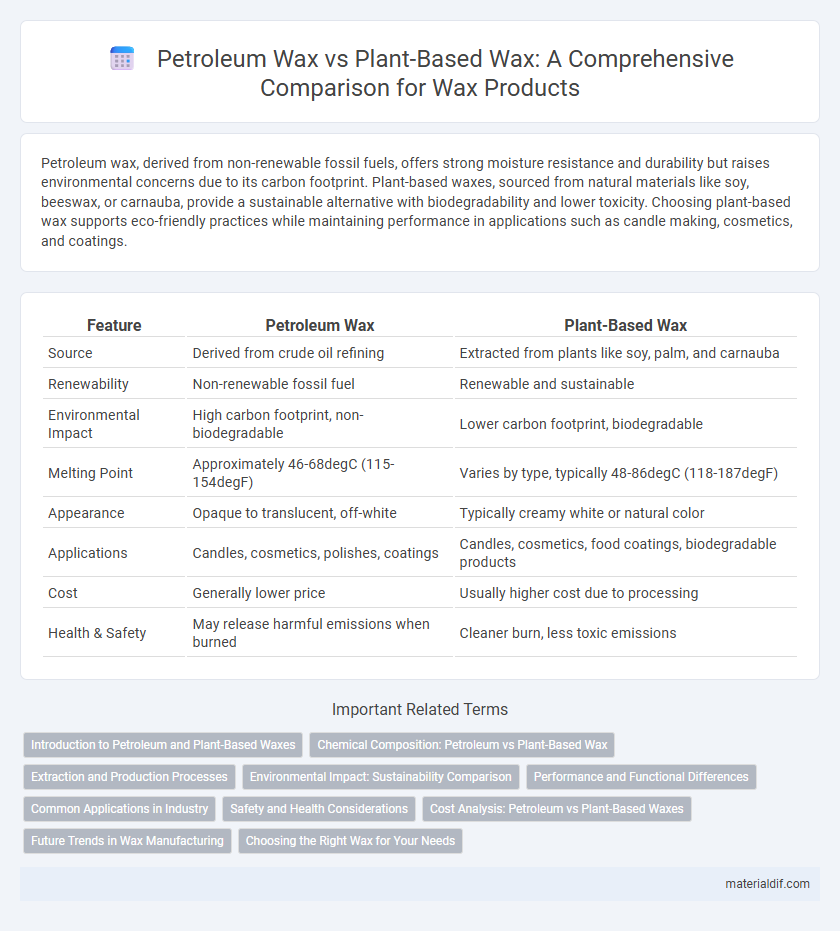Petroleum wax, derived from non-renewable fossil fuels, offers strong moisture resistance and durability but raises environmental concerns due to its carbon footprint. Plant-based waxes, sourced from natural materials like soy, beeswax, or carnauba, provide a sustainable alternative with biodegradability and lower toxicity. Choosing plant-based wax supports eco-friendly practices while maintaining performance in applications such as candle making, cosmetics, and coatings.
Table of Comparison
| Feature | Petroleum Wax | Plant-Based Wax |
|---|---|---|
| Source | Derived from crude oil refining | Extracted from plants like soy, palm, and carnauba |
| Renewability | Non-renewable fossil fuel | Renewable and sustainable |
| Environmental Impact | High carbon footprint, non-biodegradable | Lower carbon footprint, biodegradable |
| Melting Point | Approximately 46-68degC (115-154degF) | Varies by type, typically 48-86degC (118-187degF) |
| Appearance | Opaque to translucent, off-white | Typically creamy white or natural color |
| Applications | Candles, cosmetics, polishes, coatings | Candles, cosmetics, food coatings, biodegradable products |
| Cost | Generally lower price | Usually higher cost due to processing |
| Health & Safety | May release harmful emissions when burned | Cleaner burn, less toxic emissions |
Introduction to Petroleum and Plant-Based Waxes
Petroleum wax, derived from the refining of crude oil, is a hydrocarbon-based substance widely used in candles, coatings, and cosmetics due to its affordability and consistent melting point. Plant-based waxes, sourced from natural materials like soybeans, carnauba leaves, and candelilla plants, offer renewable and biodegradable alternatives with distinct textures and melting ranges suitable for eco-friendly applications. Understanding the differences in origin, chemical composition, and environmental impact helps in selecting the optimal wax for specific industrial and consumer uses.
Chemical Composition: Petroleum vs Plant-Based Wax
Petroleum wax consists primarily of long-chain hydrocarbons derived from crude oil, with a high concentration of paraffins and microcrystalline structures, providing a stable, non-biodegradable material. Plant-based waxes, such as carnauba and candelilla, are composed mainly of esters, fatty acids, and alcohols, offering renewable, biodegradable alternatives with distinct melting points and chemical reactivities. The differing molecular compositions influence their applications in industries such as cosmetics, coatings, and food packaging, where biodegradability and sustainability are increasingly prioritized.
Extraction and Production Processes
Petroleum wax is derived from the refining of crude oil through processes like solvent dewaxing and hydrocracking, resulting in paraffin and microcrystalline waxes. Plant-based waxes are extracted from natural sources such as carnauba leaves, candelilla plants, or soybeans using mechanical pressing or solvent extraction methods. Both wax types undergo purification, but petroleum wax relies on complex petrochemical refining, whereas plant-based waxes depend on sustainable agricultural harvesting and natural extraction techniques.
Environmental Impact: Sustainability Comparison
Petroleum wax, derived from non-renewable fossil fuels, contributes to greenhouse gas emissions and environmental pollution during extraction and refining processes. Plant-based waxes, obtained from renewable resources such as soy, palm, and rapeseed, offer greater biodegradability and lower carbon footprints, promoting sustainable agriculture practices. The shift towards plant-based waxes supports reduced dependency on finite resources and aligns with global efforts to mitigate environmental degradation and climate change.
Performance and Functional Differences
Petroleum wax, derived from crude oil, offers superior hardness, melting point consistency, and moisture resistance, making it ideal for industrial applications like candle making and coatings. Plant-based waxes, such as soy or beeswax, provide better biodegradability, renewable sourcing, and a softer texture, which enhances scent retention and eco-friendly appeal. Performance-wise, petroleum wax excels in durability and stability, while plant-based waxes prioritize environmental sustainability and versatility in cosmetic and food packaging uses.
Common Applications in Industry
Petroleum wax, widely used in candle making, packaging, and cosmetics, offers superior melting points and hardness, making it ideal for coatings and polishes. Plant-based wax, such as soy or carnauba, finds common applications in food packaging, pharmaceuticals, and personal care products due to its biodegradability and renewable origin. Both wax types serve the textile industry for fabric finishing, but plant-based waxes are preferred in eco-friendly product lines.
Safety and Health Considerations
Petroleum wax, derived from crude oil refining, contains hydrocarbons that may release harmful fumes when burned, posing respiratory risks and skin irritation for sensitive individuals. In contrast, plant-based waxes such as soy or beeswax are generally non-toxic, biodegradable, and emit fewer pollutants, making them safer for indoor air quality and overall health. Choosing plant-based waxes reduces exposure to potentially carcinogenic compounds commonly associated with petroleum derivatives.
Cost Analysis: Petroleum vs Plant-Based Waxes
Petroleum waxes, derived from fossil fuels, typically have a lower production cost due to established extraction and refining processes, making them more economical for large-scale applications. Plant-based waxes, sourced from renewable materials like soy, carnauba, and candelilla, often incur higher costs due to agricultural variability and more complex extraction methods. Despite the higher price, plant-based waxes are favored in sustainable markets for their biodegradability and reduced environmental impact, influencing cost-benefit considerations beyond mere price comparison.
Future Trends in Wax Manufacturing
Future trends in wax manufacturing emphasize sustainability, with plant-based waxes gaining traction due to their renewable sources and lower environmental impact compared to petroleum wax. Innovations in bio-wax formulations and improved extraction technologies are enabling higher purity and performance, positioning plant-based wax as a viable alternative in cosmetics, packaging, and candles. Industry projections forecast increased investment in eco-friendly waxes to meet growing consumer demand for green products and regulatory pressures on fossil fuel derivatives.
Choosing the Right Wax for Your Needs
Petroleum wax, derived from crude oil refining, offers superior hardness and a higher melting point ideal for industrial uses and long-lasting candles, while plant-based waxes like soy and palm provide biodegradable, renewable alternatives favored for eco-conscious consumers. Choosing the right wax depends on application needs such as durability, burn time, environmental impact, and scent throw. For sustainable options, plant-based waxes reduce carbon footprint and support cleaner air quality, whereas petroleum wax ensures consistency and affordability for mass production.
Petroleum wax vs Plant-based wax Infographic

 materialdif.com
materialdif.com